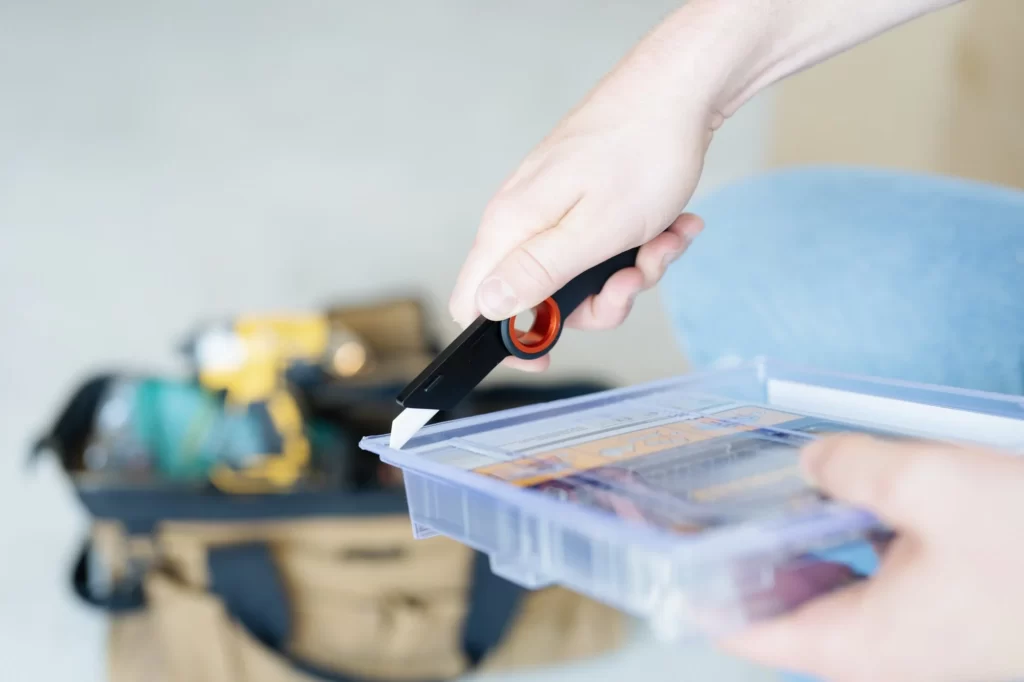Every home has cutting needs. Many tasks require a sharp blade, whether slicing through cardboard or trimming a shrub. That’s why having a quality utility knife is such an essential piece of any toolkit.
And each utility knife has its specific uses and applications. Some are better for cutting through hard materials like cardboard boxes and those annoying toy packages. Others are for more delicate work, like cutting paper.

Knowing what each knife does will help you find the right one. This guide outlines the different types of utility knives available and their uses. Let’s go.
What is a Utility Knife?
The term “utility knife” can be misleading. It doesn’t mean an all-purpose knife, but any knife used for general purposes in the home.
They are typically small and thin enough for easy handling. But they’re tough enough to withstand heavy use. A finger-friendly utility knife, for instance, should have a rubberized grip, which will prevent slipping and makes it easier to control and many of them have a built in lock feature to prevent accidential cuts when not in use.
Other types of utility knives can have various shapes of blades each made for specific usages.
Types of Utility Knives for Different Situations
These are the most common utility knives:
Hook Blades
Hook blades are a type of utility knife that features a hook-shaped blade. They are often used for cutting materials such as carpets and linoleum. These may be difficult to cut with a standard knife.
The hook shape of the blade allows the user to make curved cuts or to cut around corners and edges easily. Some hook blades are retractable, allowing the user to safely store the blade when it is not in use.
Scalloped Edges Blade

Scalloped edge blades have saw-like edges and indentations, or “scallops,” along the edge. These scallops help the blade cut through tough materials more efficiently. They can also help prevent the blade from getting stuck in thick or dense materials.
Scalloped edge blades are versatile and can be used for various tasks. This includes cutting through cardboard, packaging materials, or tape.
Serrated Edge Blades
The serrated edge blade is a knife blade with saw-like teeth along the edge. The teeth help cut through more materials than a straight-edged knife.
They can also stay sharper for longer. This is because they do not have as much surface area contact with the materials being cut.
You can use the serrated edge blade for cutting through rope or plastic packaging.

Pointed Tip Blades
Pointed tip blades, also known as spear point blades, are a type of blade commonly found on utility knives. These blades have a sharp, pointed tip that is useful for making precise cuts. They’re also excellent for piercing materials.
They are often used for cutting tape, opening packages, or making intricate cuts in materials. The pointed tip makes it easy to get into tight corners or to follow a straight line when cutting.
Rounded Tip Blades
Rounded tip blades have rounded or curved tips. They are designed to prevent the blade from puncturing or piercing the cut material. This makes them ideal for cutting delicate or easily damaged materials. This can include foam, rubber, or thin plastic.
Rounded tip blades are often used in applications where precision cutting is necessary. These include crafts, hobbies, and other tasks where a clean, smooth cut is desired.

Snap-Off Blades
Snap-off blades are disposable. So they can be quickly snapped off at the end of their life. They are generally made from high-carbon alloy steel. These knives have a serrated edge that allows them to easily slice through materials.
This makes them ideal for cutting through thick materials quickly. These include when working on vehicles or other heavy machinery.
Retractable Blade Knives
Retractable blade knives have blades that can be extended and retracted. These knives are often used for cutting and slicing materials such as cardboard. The blade can be locked in place when extended, allowing for more precise cutting.
The ability to retract the blade also helps to keep the knife safe when not in use. Retractable blade knives are convenient and versatile tools for many tasks.
Fixed blade knives
A fixed-blade knife is a knife in which the blade is fixed to the handle. They are unlike folding knives in which you can fold the blade into the handle. Fixed-blade knives are often stronger and more durable than folding knives. This makes them a good choice for use as utility knives.
You can use them for many tasks, such as cutting, slicing, carving, and more. Examples of fixed-blade knives include hunting, survival, and tactical knives.
Breakaway blade knives
These utility knives feature blades that can easily break off at predetermined break points. This allows users to easily switch between different blade sizes. You can also replace a dull blade without carrying a whole new knife.
The blades are typically made of high-quality steel and are durable and long-lasting. These knives are commonly used for various applications, including cutting, slicing, and trimming.
Conclusion
Many utility knives are available for various cutting situations. You can use them in home and outdoor settings. A utility knife can handle any cutting task. They can be standard retractable blades or heavy-duty fixed blades. With the proper selection, a utility knife can quickly and efficiently solve your cutting needs.
Marissa is a Pediatric Occupational Therapist turned stay-at-home mom who loves sharing her tips, tricks, and ideas for navigating motherhood. Her days are filled starting tickle wars and dance parties with three energetic toddlers and wondering how long she can leave the house a mess until her husband notices. When she doesn’t have her hands full of children, she enjoys a glass (or 3) of wine, reality tv, and country music. In addition to blogging about all things motherhood, she sells printables on Etsy and has another website, teachinglittles.com, for kid’s activity ideas.



